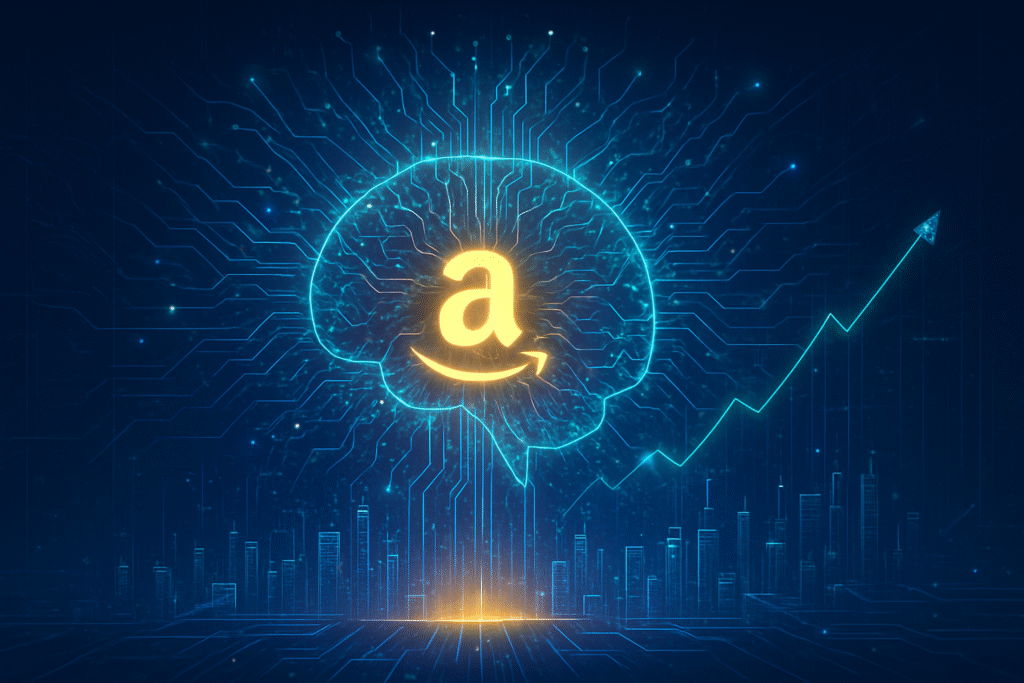
Amazon's strategic and expansive investment in Artificial Intelligence (AI) has demonstrably impacted its Q3 2025 financial performance, with the company reporting robust growth driven largely by its AI initiatives. These developments are not isolated but are deeply embedded within the broader AI landscape, characterized by rapid advancements in generative and agentic AI, and are reshaping economic and societal paradigms while also raising significant concerns. The e-commerce giant's strong quarterly results, particularly fueled by its aggressive AI push, are not only bolstering its own bottom line but are also sending positive ripples across the tech stock market, significantly influencing overall investor confidence as the industry navigates a transformative AI era.
For the third quarter ending September 30, 2025, Amazon (NASDAQ: AMZN) reported exceptionally strong results, significantly exceeding analyst expectations. Net sales climbed 13% year-over-year to reach $180.2 billion, or 12% excluding foreign exchange impacts, surpassing earlier forecasts. Net income saw a sharp increase to $21.2 billion, equating to $1.95 per diluted share, comfortably beating Wall Street's expectation of $1.57 per share. This performance was crucially bolstered by a $9.5 billion pre-tax gain related to Amazon's strategic investment in the AI startup Anthropic. Amazon Web Services (AWS), the company's highly profitable cloud computing arm, was a standout performer, with revenue surging 20.2% year-over-year to $33.0 billion, marking AWS's fastest growth rate since 2022 and exceeding analyst estimates. This robust performance and bullish Q4 2025 outlook have largely restored investor confidence in Amazon's trajectory and the broader tech sector's momentum.
Amazon's Technical AI Advancements: Powering the Future of Cloud and Commerce
Amazon's Q3 2025 financial results underscore the significant impact of its strategic investments and technical advancements in artificial intelligence. The company's strong performance is attributed to specific technical advancements across AWS's generative AI offerings, custom AI chips, and innovative AI applications in retail.
AWS's Generative AI Offerings: Bedrock and SageMaker
Amazon's generative AI strategy centers around democratizing access to powerful AI capabilities through services like Amazon Bedrock and tools within Amazon SageMaker. Amazon Bedrock is an AWS-managed service providing access to a variety of foundation models (FMs) and large language models (LLMs) from Amazon (like Titan and Nova models) and third-party providers such as Anthropic, Stability AI, OpenAI, DeepSeek, and Qwen. It enables developers to easily build and scale generative AI applications, supporting Retrieval-Augmented Generation (RAG) to enhance model responses with proprietary data. Bedrock differentiates itself by offering a fully managed, pay-as-you-go experience, abstracting infrastructure complexities and lowering the barrier to entry for businesses, while emphasizing enterprise-grade security and responsible AI.
Custom AI Chips: Trainium2 and Project Rainier
Amazon's custom AI chip, Trainium2, is a cornerstone of its generative AI infrastructure, significantly contributing to the strong Q3 results. Amazon reported Trainium2 as a multi-billion-dollar business, fully subscribed and growing 150% quarter-over-quarter. Each Trainium2 chip delivers up to 1.3 petaflops of dense FP8 compute and 96 GiB of High Bandwidth Memory (HBM3e). The NeuronLink-v3 provides 1.28 TB/sec bandwidth per chip for ultra-fast communication. AWS offers Trn2 instances with 16 Trainium2 chips, and Trn2 UltraServers with 64 chips, scaling up to 83.2 peak petaflops. This represents a 4x performance uplift over its predecessor, Trainium1. Notably, Project Rainier, a massive AI compute cluster containing nearly 500,000 Trainium2 chips, is actively being used by Anthropic to train and deploy its leading Claude AI models, demonstrating the chip's scalability. Amazon asserts Trainium2 offers a 30-40% better price-performance ratio compared to current-generation GPU-based EC2 P5e/P5en instances from competitors like Nvidia (NASDAQ: NVDA), challenging its market dominance in AI hardware.
AI Applications in Retail: Rufus and Help Me Decide
Amazon's retail segment has also seen significant AI-driven enhancements. Rufus, a generative AI-powered expert shopping assistant, is trained on Amazon's vast product catalog, customer reviews, and external web information. It utilizes a custom Large Language Model (LLM) and Retrieval-Augmented Generation (RAG) to provide contextual, conversational assistance. Rufus saw 250 million active customers in 2025, with monthly users up 140% and interactions up 210% year-over-year, and is on track to deliver over $10 billion in incremental annualized sales. The "Help Me Decide" feature, another AI-powered shopping assistant, analyzes browsing activity and preferences to recommend the most suitable product with a single tap, reducing decision fatigue and streamlining the shopping process. These tools represent a significant departure from traditional keyword-based search, leveraging natural language understanding and personalized recommendations to enhance customer engagement and sales.
Competitive Implications and Market Repositioning
Amazon's AI advancements and robust Q3 2025 performance are significantly reshaping the competitive landscape across the tech industry, impacting tech giants, specialized AI companies, and startups alike.
Beneficiaries: AWS itself is the most prominent beneficiary, with its accelerated growth validating massive infrastructure investments. Anthropic, a recipient of an $8 billion investment from Amazon, is deeply integrating its Claude AI models into Amazon's ecosystem. AI model developers like AI21 Labs, Cohere, Stability AI, and Meta (NASDAQ: META), whose models are hosted on AWS Bedrock, gain increased visibility. Semiconductor companies like Nvidia (NASDAQ: NVDA) and Intel (NASDAQ: INTC) also benefit from Amazon's substantial capital expenditure on AI infrastructure, though Amazon's custom chips pose a long-term challenge to Nvidia. AI startups leveraging AWS's Generative AI Accelerator program and third-party sellers on Amazon using AI tools also stand to gain.
Competitive Pressure: Amazon's "platform of choice" strategy with Bedrock, offering diverse foundational models, creates a competitive challenge for rivals like Microsoft (NASDAQ: MSFT) and Google (NASDAQ: GOOGL), who are more tied to specific proprietary models. While AWS remains the cloud market leader, it faces intense competition from Microsoft Azure and Google Cloud, which are also investing billions in AI and expanding their infrastructure. Smaller AI labs and startups outside the AWS ecosystem face significant barriers to entry given the massive scale and subsidized services of tech giants. Amazon has also intensified efforts to block AI companies, including Meta, Google, Huawei, Mistral, Anthropic, and Perplexity, from scraping data from its e-commerce platform, indicating a proprietary view of its data assets.
Competitive Implications for Major Tech Companies:
- Microsoft: Microsoft's strategy leverages its productivity software, OpenAI partnership, and Azure cloud infrastructure, integrating AI across its consumer and cloud services.
- Google: Google focuses on infusing AI across its consumer and cloud services, with a full-stack AI approach that includes its Gemini models and TPUs. Despite Amazon's investment in Anthropic, Google has also deepened its partnership with Anthropic.
- Nvidia: While Nvidia remains a crucial partner and beneficiary in the short term, Amazon's heavy investment in custom AI chips like Trainium2 (a multi-billion dollar business itself) aims to reduce dependency on external vendors, posing a long-term competitive challenge to Nvidia's market dominance in AI hardware.
Potential Disruption: Amazon's AI advancements are driving significant disruption. AI is hyper-personalizing e-commerce through Rufus and other tools, projected to add over $10 billion in annual sales. AI and robotics are optimizing logistics, cutting processing times by 25%, and setting new industry standards. AI enhances Alexa and the broader Alexa+ ecosystem. Amazon's aggressive pursuit of AI and robotics aims to improve safety and productivity, with internal documents suggesting the company might need significantly fewer new hires in the future due to automation, potentially impacting labor markets.
Market Positioning and Strategic Advantages: Amazon's market positioning in AI is characterized by its cloud computing dominance (AWS), the "democratization" of AI via Bedrock's diverse model offerings, vertical integration with custom silicon, and its e-commerce data flywheel. Its operational excellence and strategic partnerships further solidify its advantage, all supercharged by aggressive AI investments.
The Wider Significance of Amazon's AI Push
Amazon's strategic and expansive investment in Artificial Intelligence (AI) is not just reshaping its financial performance; it's deeply embedded within a rapidly evolving global AI landscape, driving significant economic and societal shifts.
Broader AI Landscape and Current Trends: Amazon's initiatives align with several prominent trends in late 2024 and 2025. Generative AI proliferation continues to transform creative processes, becoming a top tech budget priority. Amazon is "investing quite expansively" with over 1,000 generative AI services and applications in progress. The rise of Agentic AI systems in 2025, capable of autonomous task handling, is another key area, with AWS AI actively funding research in this domain. Multimodal AI integration and Edge AI adoption are also significant, enhancing user interactions and enabling faster, more secure solutions. Crucially, there's an increasing focus on Ethical AI and Responsible Development, with pressure on tech giants to address risks like bias and privacy.
Overall Impacts on the Economy and Society: AI has emerged as a significant driver of economic growth. Many economists estimate that AI-related capital expenditures contributed over half of America's 1.6% GDP growth in the first half of 2025. The International Monetary Fund (IMF) projects that AI will boost global GDP by approximately 0.5% annually between 2025 and 2030. AI is enhancing productivity and innovation across diverse industries, from optimizing business processes to accelerating scientific discovery. Societally, AI's influence is pervasive, affecting employment, education, healthcare, and consumer behavior.
Potential Concerns:
- Job Displacement: One of the most pressing concerns is job displacement. Amazon's ambitious automation goals could eliminate the need for over 600,000 future hires in its U.S. workforce by 2033. CEO Andy Jassy explicitly stated that generative AI is expected to "reduce our total corporate workforce" through efficiency gains, with 14,000 corporate employees laid off in October 2025, partly attributed to AI innovation.
- Ethical AI Challenges: Concerns include privacy issues, algorithmic bias, discrimination, and a lack of transparency. Amazon has faced shareholder resolutions regarding oversight of data usage. Past incidents, like Amazon's recruitment tool exhibiting bias against female candidates, highlight how AI can perpetuate historical prejudices.
- Privacy Concerns: The vast amounts of personal data collected by Amazon, when leveraged by AI, raise questions about unconstrained data access and the potential for AI-driven business decisions to prioritize profit over ethical considerations.
- Environmental Impact: The increasing demand for computing power for AI is leading to a significant rise in energy consumption, with the IMF estimating AI-driven global electricity needs could more than triple to 1,500 TWh by 2030, raising concerns about increased greenhouse gas emissions.
Comparisons to Previous AI Milestones: The current wave of AI, particularly generative AI, is considered by many to be the most transformative technology since the internet. Unlike earlier AI milestones that often served as backend enhancements or specialized tools, today's generative AI is directly integrated into core business operations, becoming a front-facing, interactive, and transformative force. This pervasive integration into strategic functions, creativity, and customer interaction marks a significant evolution from prior AI eras, driving companies like Amazon to make unprecedented investments.
The Horizon: Future Developments in Amazon's AI Journey
Amazon is aggressively advancing its Artificial Intelligence (AI) initiatives, with a clear roadmap for near-term and long-term developments that build on its strong Q3 2025 performance.
Expected Near-Term Developments (Late 2025 – 2026): In the near term, Amazon is focusing on expanding its AI infrastructure and enhancing existing AI-powered services. This includes continued massive capital expenditures exceeding $100 billion in 2025, primarily for AI initiatives and AWS expansion, with even higher spending projected for 2026. Further development of custom AI chips like Trainium3 is anticipated, expected to surpass current flagship offerings from competitors. Generative AI services like AWS Bedrock will continue to integrate more foundation models, and Amazon Q, its agentic coding environment, will see further enterprise improvements. Alexa+ is being enhanced with "agentic AI features" to make decisions and learn from interactions, aiming to dominate the consumer-facing AI agent market. Amazon's robotics team is also pushing to automate 75% of its operations, implementing advanced robotics and AI to improve logistics and warehouse efficiency.
Long-Term Future Developments: Amazon's long-term vision involves a comprehensive, AI-powered ecosystem that continually reinvents customer experiences and operational efficiency. AI is expected to permeate virtually every part of Amazon, from cloud computing to robots in warehouses and Alexa. The company envisions a future where AI agents become "teammates" that accelerate innovation by handling rote work, allowing human employees to focus on strategic thinking. Beyond individual assistants, Amazon is focused on building and leveraging multiple new agents across all its business units and incubating future AI businesses in areas like healthcare (AI-enabled virtual care) and autonomous vehicles (Zoox robotaxis).
Potential Applications and Use Cases on the Horizon:
- Retail and E-commerce: Continued advancements in personalized recommendations, AI-powered search relevancy, and voice shopping through Alexa+ will enhance customer experience.
- Cloud Computing (AWS): AWS will remain a core enabler, offering increasingly sophisticated generative AI and agentic AI services, machine learning tools, and optimized AI infrastructure.
- Logistics and Supply Chain: AI will continue to optimize inventory placement, demand forecasting, and robot efficiency, leading to improved cost-to-serve and faster delivery speeds.
- Healthcare and Life Sciences: Generative AI is being explored for designing new molecules and antibodies for drug discovery.
Challenges That Need to Be Addressed: Amazon faces significant technical, ethical, and competitive challenges. Technical hurdles include ensuring data quality and mitigating bias, improving contextual understanding in AI, and managing integration complexities and "hallucinations" in LLMs like Amazon Q. Ethical challenges revolve around algorithmic bias, privacy concerns (e.g., confidential information leakage with Amazon Q), and the societal impact of job displacement due to automation. Competitively, Amazon must maintain its cloud AI market share against rivals like Microsoft Azure and Google Cloud, address feature parity with competitors, and manage the high integration costs for customers.
Expert Predictions: Experts predict Amazon is positioned for a significant breakout in 2026, driven by its robust retail business, accelerating AI demand within AWS, and expanding high-margin advertising. Amazon's strategic investments in AI infrastructure and its three-tier AI stack (infrastructure, model customization, application) are expected to drive lasting adoption. While AI is expected to reduce the need for many current roles, it will also create new types of jobs, necessitating AI skills training. The focus in generative AI will shift from simply adopting large language models to how companies leverage AI with proprietary data within cloud architectures.
A New Era: Amazon's AI-Driven Transformation and Its Broader Implications
Amazon's aggressive pivot towards Artificial Intelligence is not merely a strategic adjustment; it represents a fundamental re-engineering of its business model, with its Q3 2025 earnings report serving as a powerful testament to AI's immediate and future impact. This commitment, underscored by massive capital expenditures and deep integration across its ecosystem, signals a transformative era for the company and the broader tech industry.
Summary of Key Takeaways: Amazon has unequivocally positioned AI as the central engine for future growth across AWS, e-commerce, and internal operations. The company is making substantial, near-term financial sacrifices, evidenced by its over $100 billion capital expenditure plan for 2025 (and higher for 2026), to build out AI capacity, with CEO Andy Jassy asserting, "The faster we add capacity, the faster we monetize." This reflects a full-stack AI approach, from custom silicon (Trainium) and massive infrastructure (Project Rainier) to foundational models (Bedrock) and diverse applications (Rufus, Connect, Transform). The recent layoffs of approximately 14,000 corporate positions are presented as a strategic move to streamline operations and reallocate resources towards high-growth AI development, reflecting a maturing tech sector prioritizing efficiency.
Significance in AI History: Amazon's current AI push is profoundly significant, representing one of the largest and most comprehensive bets on AI by a global tech giant. By investing heavily in foundational AI infrastructure, custom chips, and deeply integrating generative AI into both enterprise and consumer services, Amazon is not just aiming to maintain its leadership; it seeks to fundamentally revolutionize its operations and customer experiences. CEO Andy Jassy has called this generation of AI "the most transformative technology we've seen since the internet," underscoring its historical importance. This aggressive stance, coupled with its strategic investment in Anthropic and the development of large compute clusters, indicates an intent to be a foundational player in the AI era.
Final Thoughts on Long-Term Impact: Amazon's current trajectory suggests a long-term vision where AI permeates every aspect of its business model. The massive capital expenditures are designed to yield substantial returns by capturing the exploding demand for AI services and enhancing efficiencies across its vast ecosystem. If successful, these investments could solidify AWS's dominance, create highly personalized and efficient shopping experiences, and significantly reduce operational costs through automation and robotics. This could lead to sustained revenue growth, improved profitability, and a reinforced competitive moat in the decades to come, transforming Amazon into a "leaner and faster" company, driven by AI-powered innovation.
What to Watch For in the Coming Weeks and Months:
- Capital Expenditure vs. Free Cash Flow: Analysts will closely monitor how Amazon's aggressive capital expenditure impacts free cash flow and the speed at which these investments translate into monetization and improved margins.
- Trainium3 Performance and Adoption: The market will watch the preview and subsequent full release of Trainium3 in late 2025 and early 2026 to assess its performance against rival AI chips and its adoption by customers.
- Further Generative AI Integrations: Expect more announcements regarding the integration of generative AI across Amazon's consumer products, services, and seller tools, particularly in "agentic commerce."
- AWS AI Market Share: Continued monitoring of AWS's growth rate relative to competitors like Microsoft Azure and Google Cloud will be crucial to assess its long-term positioning.
- Impact of Layoffs and Upskilling: The effectiveness of Amazon's corporate restructuring and upskilling initiatives in fostering efficiency and a stronger AI-focused workforce will be key.
- Q4 2025 Outlook: Amazon's guidance for Q4 2025 will provide further insights into the near-term expectations for AI-driven growth heading into the critical holiday season.
This content is intended for informational purposes only and represents analysis of current AI developments.
TokenRing AI delivers enterprise-grade solutions for multi-agent AI workflow orchestration, AI-powered development tools, and seamless remote collaboration platforms.
For more information, visit https://www.tokenring.ai/.




